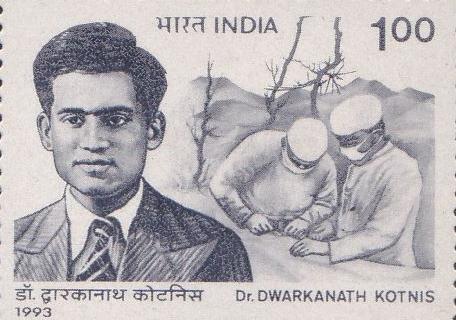Dr Dwarkanath Kotnis No other Indians can claim the kind of adulation and reverence that Dr. Dwarkanath Kotnis enjoys in China

A bronze statue, known in China as Ke Dihua, of Indian doctor Dwarkanath Kotnis would be unveiled outside a medical school in North China.No other Indians can claim the kind of adulation and reverence that Dr. Dwarkanath Kotnis enjoys in China. A legendary Indian physician, who dedicated his entire life working as a battlefront doctor in China, is indeed a name to reckon with.
Early Life
Dr. Dwarkanath Kotnis was born in a lower middle class family on October 10, 1910 in Sholapur, Mumbai. After completing his graduation in medicine from G. S. Medical College, Bombay, he went on to pursue his post-graduation internship. However, he shelved his post-graduation plans when he got the chance to join the medical aid mission to China. Sensing the crisis there, he willingly volunteered to help the people.
Career
Dr. Kotnis always wanted to travel around the world and practice medicine in different parts of the globe. He started his medical expedition in Vietnam, and then, moved on to Singapore and Brunei. In 1937, the communist General Zhu De requested Jawaharlal Nehru to send Indian physicians to China during the Second Sino-Japanese War to help the soldiers. The President of the Indian National Congress, Netaji Subhash Chandra Bose accepted the request and made arrangements to send a team of volunteer doctors. A medical team of five doctors was sent as the part of Indian Medical Mission Team in September 1938. The medical team comprised of M. Atal, M. Cholkar, D. Kotnis, B.K. Basu and D. Mukerji. After the war, all other doctors except Dr. Kotnis, returned back to India. However, Dr. Kotnis decided to stay back and serve at the military base. He initially started his work in Yan'an and then went to the anti-Japanese base area in North China where he worked in the surgical department of the Eighth Route Army General Hospital as the physician-in-charge. Kotnis made China his home and joined the Communist Party of China in July 1942.He also worked as a lecturer for sometime in the Military area at the Dr. Bethune Hygiene School. He took over the post of the first president of the Bethune International Peace Hospital after Dr. Norman Bethune passed away.
Contribution
Dr. Kotnis' major contribution was his selfless service to the Chinese soldiers in the battlefield during the Second Sino-Japanese War. He had the heart to stay back in China, even when his colleagues left, just for serving the wounded soldiers during the war. Because of his loyalty, the young Indian doctor became a legendary figure in China.
In China revered as a hero:
The stamps bearing his picture have been printed in China. He was chosen as one of the “top 10 foreigners” in a 2009 internet poll of China’s foreign friends in a century. He is regarded as a symbol of Sino-Indian friendship.
Mao Zedong was deeply affected by his death and Mao wrote in his eulogy that “the army has lost a helping hand, the nation has lost a friend. Let us always bear in mind his internationalist spirit”.